Here is a blog-post version of the poster to accompany the AMS paper discussed in the previous post.
You can download a printable, high rez (11 MB) version of the poster here, or a low rez (1 MB) version here.
—————————
—————————
In the part III, I’ll publish the conference paper that provides the details behind the poster/slideshow presented here.






.png)


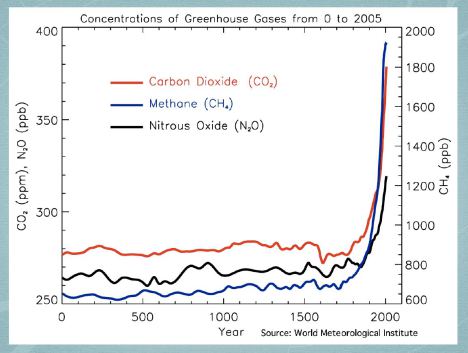
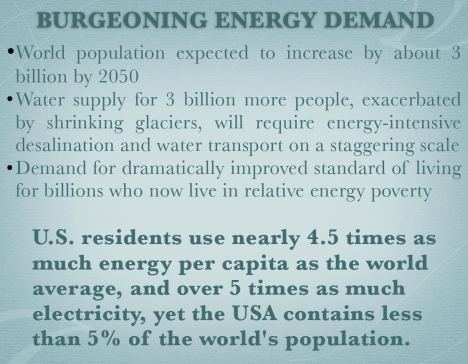

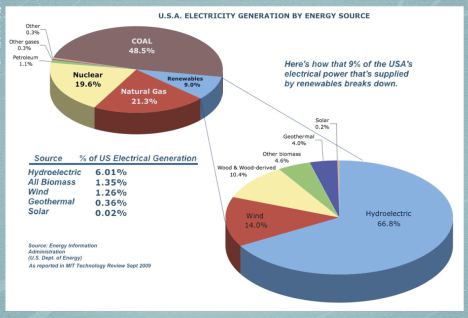
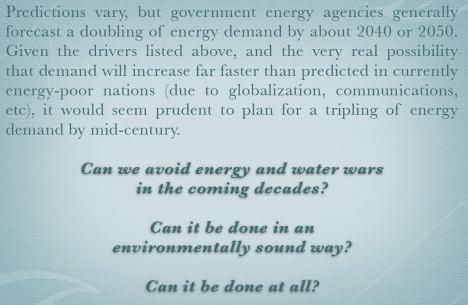
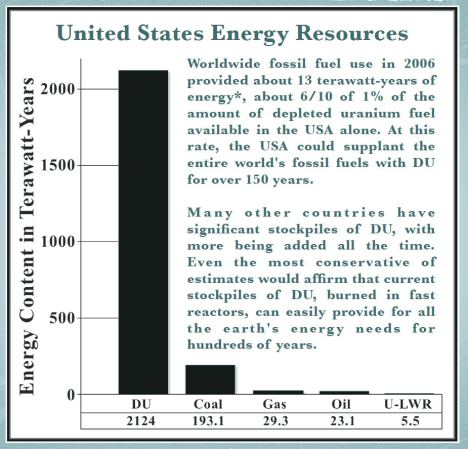

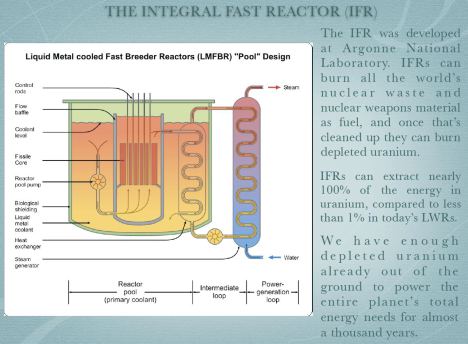
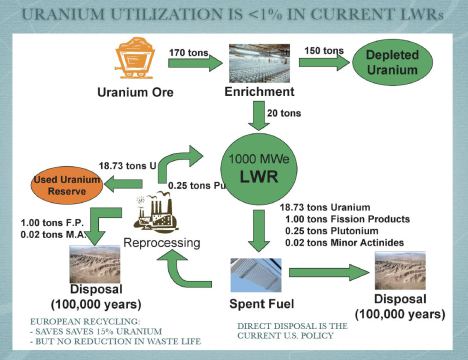

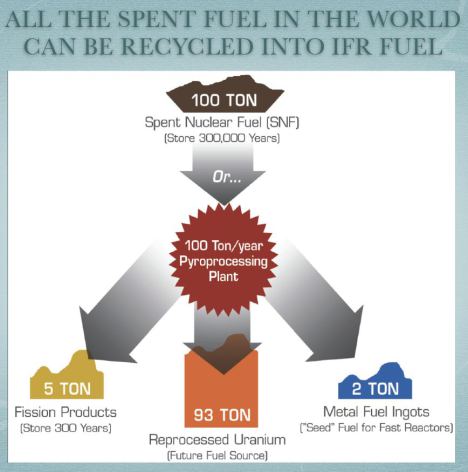
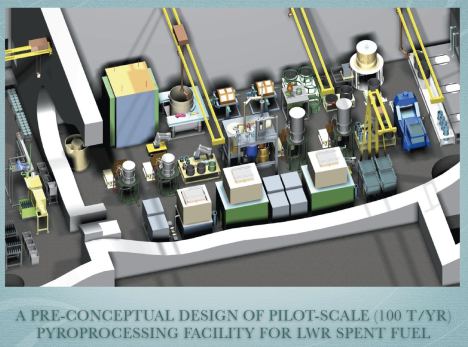









Great poster! What was the reaction on the conference floor, and which authors were present?
Dark Side of the Moon poster for “Prism” … How’d you get copyright for that?
I haven’t thought of that album since the late 70s.
Well done for avoiding the bogeyman- word “breeder” and using “recycling” instead. The point is:
IFR – gets rid> of your nuclear waste!
IFR – recycles waste to energy!
What’s not to like?
One of the benefits which could be added to the list is the production of fresh water.
.
During the production of 1 kW of electricity, between 3 and 4 kW of heat must be removed. Considering that the latent heat of vaporisation of water is 2.26 kJ per gram, that heat flux could be used to distil off 1 g/s of freshwater. That amounts to 30 kL/a (i.e., tonnes per year ).
.
Considering that Australians use about 160 kL/a , the conversion of thermal output to drinkable water should be counted as a considerable virtue of nuclear electricity production.
.
The back-of-envelope calculation above can be improved on. More efficiently, multi stage distillation uses the latent heat repeatedly to produce several times as much water. Off-peak electricity could be used with reverse osmosis as well.
.
That surely has to be a valuable consideration for Australia at least, and indeed any community living away from the coast.
Thanks Roger, back-of-the-envelope calculations like that are very helpful for understanding/education.
turnages, I think the other bogey word is “reprocessing” rather than recycling – probably what you meant?
Can you direct me to detailed information about the pre-conceptual design of a pyroprocessing plant?
this is great, you guys. congratulations. a couple of questions, ones I’ve asked before (sorry, I’m dense).
barry, you have said that the efficiency number with IFRs can vary from 150x to 180x depending on the details of the processing. George Stanford has said 100x and the pp here says 100x (“100x uranium energy extraction).
It is confusing to ordinary people and we could be accused of hype should we choose the higher numbers. why not offer a range of efficiencies the first time? would that not be less misleading?
second, and I keep raising this point and would like not tohave to raise it, but emphasizing the advantages of the IFR on waste disposal time-300 vs. 100,000 years due to minor actinides with long half lives-cannot but reinforce radiophobia. anti nukes reading the reasoning here can then justify their fear of uranium 238 due to its much longer half life.
I just don’t think you can leave it at that!! there’s crazy uninformed fear of radiation out there and to counter it, we indicate that it is the fission products that are the real worry, NOT THE ELEMENTS WITH LONG HALF LIVES. but then we turn around and in practice say that the advantage of the IFR is that we avoid precisely those long half lives we otherwise say are not a problem.
I’d really like to get people’s opinions on this. because every time I raise the damn point, people agree that the long half lives business is largely a bogus worry. but if it’s a bogus worry, why treat it like it’s not: because of what the public thinks?
we have to change what the public thinks. Look: pretend you’re a student trying to understand just what is the issue with radiation. do you think presentations like this otherwise spectacular one can’t be handled by our opponents in such a way as to make it look like we’re talking out of both sides of our mouth?
thus, they get to hit us with the double standard charge, which is such a notable and nauseating feature of anti nuclear discourse. and the hall of mirrors projection fest will continue.
It should be said that Tom’s great work on informing people about the IFR did EMPHASIZE (I think wrongly) the distinctions on the waste issue (the radiation part of the waste issue) between gen four and current reactors. Many of us on this site now think this to have been a bad move-bending the stick in the other direction a bit too far.
Tom makes a great point in his book (to the soft lefties) that instead of shooting missiles at Iraqis made from DU, burn the DU as energy. terrific, but in doing this, we cannot feed the DU radiotoxic scare by reinforcing (unwittingly) the common view that materials with 100,000 year half lives are dangerous-thus implying that DU is even more dangerous.
Burning DU as fuel is a great idea because of the efficiencies involved; not because you are getting rid of a very dangerous substance that “condemns humanity for eternity,” etc, just to give you a piece of literal anti nuclear discourse around DU.
btw, George Stanford said (in his piece on IFRs a number of months ago) that even though the waste issue is largely a bogus issue, that the 100,000 year business responds to legal requirements.
fine: I get that. but it needs to be made clear to people that the law is based on scare premises and are thus misleading.
others have commented on a tendency to bad mouth one technology because you happen to favor another. bad mouth IFRs if you support LFTRs (I think this charge is not ENTIRELY FAIR to people like Charles Barton). Make LWRs look worse than they are in order to pump up IFRs, etc.
Sometimes I think we need to purge ruthlessly the advertising executive in ourselves.
According to my math 1000kg of Uranium-238 will create 8.86 × 10^9 kilowatt hours @ 38% efficiency, or basically exactly 150 times more electricity than the same amount of natural Uranium in a LWR (assuming enrichment discards NO Uranium-235 whereas in RL it does).
If 0.2% of U-235 is lost during enrichment process, then I get the IFR being 215 times more efficient. Maybe I’m wrong…
barry from IFR facts 2:
Okay, so this is a nice, simple ‘rule of thumb’ to remember. A 1 GWe (1000 megawatt) IFR must be supplied with ~1 tonne of natural or depleted uranium per year (it doesn’t matter which). It is roughly 150 to 200 times more efficient with its fuel use than current thermal reactors.
barry, you earlier had a post where you showed the calcs for determining the energy locked up in a kg of uranium. perhaps scott used similar calcs. I can’t find that post of yours (barry’s).
Love your work Barry et al. As it is said: A picture is worth a thousand words. OK , I am sold on the IFR, turnage is right . What’s not to like
The IFR proponents conveniently forgot the existence of Thorium in their future forecasts. Does the academic world of IFR proponents acknowledges the second possibility for low cost nuclear energy??Thermal LFTR fueled with fertile thorium can do the same thing with better natural safety and lower cost.
there is no better rock album than dark side of the moon and no cooler rock cover. there may be ties, but that’s all I’m conceding.
if we can’t convince the anti nuclear people with rational argument, let’s use popular culture to manipulate.
So: (I know I made the comment above about advertising, but since we’re advertising…) GE should get the guy who plays Gandalf in LTR to be the spokesperson for the IFR-he’ll say something like “I come back to you now, here, at the turning of the tide.” the white wizard brings new magic/technology to the hobbits of middle earth.
it’ll work in new zealand where LTR was made.
Greg Meyerson,
@ 5 February 2011 at 1:48 AM
http://bravenewclimate.com/2011/02/04/an-environmentally-sound-energy-rich-future/#comment-111806
Excellent post. I agree with you entirely about the presentation of the nuclear waste argument. All the discussion about the physics and chemistry and half lives of nuclear waste components is sending entirely the wrong message. The message it is sending is that nuclear waste is an unresolved, complicated, dangerous and contentious issue and no one really knows what the hell is going on!
Why can’t we just keep it simple, like this:
1. So called ‘Nuclear waste’ (actually it is ‘Once-used nuclear fuel’) is stored in canisters like this http://www.nukeworker.com/pictures/displayimage-5205-fullsize.html until it is time to reuse the remaining energy in the fuel. These 16 canisters hold all the ‘once-used-nuclear-fuel’ from 32 years of electricity generation (44 TWh):
As you can see from the photo, the area of land required is small.
Once the remaining energy has been extracted from the used fuel, the volume of the final nuclear waste will be reduced x% and would be stored in just 1? of these canisters (someone else fill in the correct numbers please).
2. “Ah, but what about that last bit of waste? It’s toxic and lasts 300 years.”
Reply: If you were really worried about toxic waste, you’d be advocating to stop production of I-phones and all the other throw away consumer products that produce toxic chemical wastes; chemical wastes last for ever, are uncontrolled and released to the environment all over the world all the time.
on this question, I agree with you completely, Peter.
we can’t pander to the anti nukes.
also, with waste you really do need to store, I think we should not shy away from discussing the feasibility of the rip anderson idea of the seabed site in Hawaii for our canistered, vitrified, useless fission products.
avoiding this because it sounds scary just reinforces the b.s. what real objections are there to such an idea? perhaps they exist. I’d like to know what they are.
I disagree with you Greg, Peter et al about the lack of need for attending to nuclear waste. From a purely scientific and engineering point of view, you are partially correct — well, fully correct IF the choice was made to dilute and disperse the LWR waste in the oceans or go for seabed disposal. But without FP separation, this would result in an unacceptable loss of valuable actinides. If one takes the alternative approach – engineered repositories, then the removal of the actinides makes a great deal of sense from a heat-load perspective. Number one, of course, is that this is a — perhaps THE — major issue of public concern, rightly or wrongly, and fighting against this by saying the public has nothing to worry about will have about as much success as the movement to get people to ‘use less’ for the good of the environment. Ain’t gonna happen.
For further details, I’ll cite you a useful statement by one of the IFRG members on this matter:
The nuclear world is LWRs with some small amount of MOX use from aqueous reprocessing. Anything else is pie in the sky at this time, even though Korea has done a little with processing LWR fuel for CANDU reactors. Thus, the question is what to do with spent LWR fuel. Today there are four options with some significant level of industrial/government support.
1. Store it for the future. (People are now talking about qualifying storage systems for 300 years.)
2. Bury it. (YM has shown this to be a major political problem.)
3. Reprocess some for use in LWR MOX. (Fully demonstrated and to be used to dispose of 68 tons of weapons Pu in the US and Russia.)
4. Reprocess it for use in fast reactors. (Favored by many but yet to be commercialized.)
In all of these options one eventually needs high level waste disposal sites. The question is just how many.
Option 1. pushs the decision to far in the future. Option 2. and 3. will require something like 5 to 10 times what would be required if option 4. were to be introduced. The number depends on the mix of LWRs and fast reactors. And on the growth in nuclear power and development of the fast reactor. Also, nuclear development has a strong nationalist bias and the extent to which it becomes international or dominated by a few international suppliers is yet to be determined. High level waste is likely to be the last technology to be internationalized, if ever, because of “not-in-my back-yard” and the transportation complexity associated with it.
I prefer option 4. as do most in this group so I don’t know why we spend so much time on discussing other options that are very unlikely to be realized given the likely growth in use LWRs and the need to address LWR spent fuel management.
Option 1. is likely to continue in used for the foreseeable future.
It will probably be the solution preferred by the President’s committee reviewing the problem.
By the time there is any significant level of commercial reprocessing available there is going to be a huge load of spent LWR fuel setting around with tons of valuable Pu setting unused. Even when there are many IFRs there will also be many LWRs producing spent fuel. Reprocessing is needed to use the LWR fuel even if it is going into fast reactors. This could be more aqueous systems or it could be pyro, the choice should depends on cost and performance. So far aqueous appears very expensive and the cost and reliability of pyro is unknown.
What is known, is that a reprocessing plant to support demonstration of a commercial fast reactor using spent fast reactor fuel is smaller and much less expensive than one to support reprocessing a meaningful amount of LWR fuel. However, there is no spent fast reactor fuel so you need to reprocess LWR fuel to get the fast reactor going.
However, there are tens of tons of Pu in the US, France, England and Russia from aqueous reprocessing, 34 US tons will go into MOX fuel in the US and another 34 tons will go into fast reactors in Russia. So there is no technical need to reprocess LWR fuel to start the IFR.
But getting the will to build the IFR reactor may be more difficult than getting the will to demonstrate a LWR reprocessing plant for LWR fuel that is cheaper than the expensive aqueous systems. This plant may improve the access to the Pu for IFR since it will be adding to the separated inventory that the US already has.
This does not cover all the details and is not to clearly written but the bottom line is, one may be able to get support for the LWR fuel reprocessing, with no commitment to closing the fuel cycle with IFRs, than getting support for the IFR closed fuel cycle. The pyro-technology for the LWR includes what would eventually be needed for the IFR.
Regrettably, there is probably no support any alternative and the spent fuel will continued to be stored on site and at independent fuel storage system off-site. It appears to be the cheapest short term solution and may even be used for much longer than seems reasonable to us.
Frank, I/we haven’t forgotten Thorium. It gets plenty of mentions in my book, for instance. But your safety comment is not only unsupportable, it is also rather silly because we are then left arguing on whether we should be aiming for a core damage incident that occurs once every 20 million or 100 million reactor years. It’s like trying to count the number of angel that can dance on the head of a pin. The cost issue of LFTR is also unresolved, and would be infinite (per unit of commercial energy delivered vs R&D inputs) if the technology ends up with engineering show stoppers or just doesn’t get taken up commercially because it proves too difficult. I’m not saying that will happen, but I’m saying, like the safety argument, that it’s taking a the wrong hypothetical track and so constitutes a poor argument.
Barry,
@ 5 February 2011 at 4:37 PM
I understand what you are getting at; see my comments towards the end of this comment. First, I want to respond to a number of points you made in your comment.
I think I’ve been misunderstood (I wasn’t clear enough).
I was trying to make the case that we spend far too much time discussing the detailed physics and chemistry of ‘nuclear waste’ (once used fuel) management. The way the debate comes across scares the population. Of course we will move to Gen IV (and the sooner the better) and of course we will manage and burn existing and future waste, but management of existing waste from Gen II and Gen III in the meantime is not a big deal technically. It is not even a quantity problem if we can’t get over the hurdle of getting re-started with nuclear builds in the western democracies. It is only a big deal politically. The discussions on BNC about nuclear waste management, I feel, are providing lots of ammunition to continue to make it a big, scary, unresolved issue. I think that is helping to make it harder to ‘move forward’ in Australia, and especially harder for the Labor Party to develop a good policy to replace its existing anti-nuclear policy.
As far as burying nuclear waste in the ocean so as to disperse/dilute it, this was one of the options considered thoroughly by many international bodies over three decades. The clear conclusion was that geological disposal is by far the best way to manage the waste.
As an aside, the compacted clay/rock below Bruce Power Station currently being investigated by Ontario Hydro, has extremely low permeability and is ideal for nuclear waste disposal. It is right at the power station. What could be better.
Other comments:
There are always some people somewhere with some agenda talking about something. I can understand that we may want to design the storage facility to have a life expectancy of 300 years so we can use it for that long. But I doubt anyone is talking about building sufficient storage sites to allow us to store 300 years of LWR (with all the world’s electricity provided by LWRs for 300 years). (You didn’t say that, but that is the interpretation that many would take from the comment in brackets). That would be ridiculous. Surely we should work on the assumption that virtually all new builds from say 2050 on would be Gen IV and would consume waste if that is the best alternative by then (40 years away). However, I still think we are still focusing too much of our effort worrying about what is the right policy for decades hence when our efforts should be on trying to convince Labor that its new policy should be about how to set up a low-cost nuclear regime in Australia. (sorry for that diversion)
Everything to do with nuclear is a big problem in USA. That’s why they stopped building NPPs three decades ago. But Sweden and Finland are progressing with building repositories and Canada will when it needs to. As you have pointed out many times before, the issue is not urgent from a technical perspective, it is only urgent to be able to demonstrate to the public that there is a proven, viable, cost effective solution available.
This will happen in the normal course of events, when the time is right. I agree that USA, France, Germany, Russia, Japan, Korea, China and India should be conducting active research programs on Gen IV.
I absolutely agree. I didn’t mean to give the impression I disagree with this.
I agree we should not be wasting so much of our effort discussing the physics and chemistry of nuclear waste management. It is a distraction from what we should be focusing on, it is scaring the population, and it is giving the anti-nukes lots of ammunition.
The reason Option 1 is being discussed is explained by the next line in your comment:
I understand what you are getting at. This leads me to wonder as follows: clearly the CAGW Alarmists want urgent action to cut emissions rapidly and, to them, the cost is not important because they believe civilisation is at stake if we don’t. Conservatives want action to cut all pollution, in a properly balanced way (not by picking the emotive issue of the decade), but want economically rational policies to do so. To get stable policies that will survive changes of government for a long time we need to get support from majorities in both groups. So why is much of BNC’s effort committed to arguing for a price on carbon? Why not, instead, argue for removal of the impediments to low-cost nuclear? Then spend all our effort focused on defining what are the impediments to low-cost nuclear, how they could be removed and what timelines should we be working to?
If we could focus on this, instead of arguing for a carbon price, surely we could be far more effective. We may even genuinely lead the world. How about it?
Greg Meyerson,
We are of like mind. We could be brothers 🙂
I think the argument about the best place to dispose of nuclear waste has been analysed to death for 4 decades. We do not need to waste more time, effort, resources on it. It is a distraction. If we really want to get rid of it for a long time stick it in a subduction zone.
“Why not, instead, argue for removal of the impediments to low-cost nuclear? Then spend all our effort focused on defining what are the impediments to low-cost nuclear, how they could be removed and what timelines should we be working to?”
Peter, I’d like to discuss this and work towards it, sure. But I’m still not sure what to advocate along these lines that would have political resonance. I think most people in BNC feel the same. What to do, beyond the motherhood statement that virtually all of us would agree with? I really don’t see it as people avoiding this issue because it runs counter to their ideology. People are not tackling this issue because they don’t know how to and have nothing effective to say.
Barry,
Yes. I agree, that is the situation. I’m just trying to stir up action on this issue that I feel is the most important place for us to focus our attention over the next few months. I was involved in the Ecologically Sustainable Development processes in the early 1990s. I know how close we came to having excellent policies, but, in the end, spin won out over substance. I think it is highly likely the same will happen again this time. Even though Labor will dump its anti-nuclear policy late this year, and that is a positive step, I suspect we will end up committed to high-cost nuclear for the long term.
I agree. It is tough to know how to proceed so that we can have a real effect (like you and BNCers have already had in getting Labor to start preparing the electorate for the ALP dumping its anti-nuclear policy)
My suggestion is to ask a few suitably qualified people to write some articles (spaced out in time amongst the other types of articles BNC followers are interested in).
I would suggest it would be worth inviting articles from people who would not necessarily have opinions that align with the majority of BNCers. The first person I am thinking of is Alan Moran. He was a commissioner (?) of the Productivity Commission. He could write an excellent and informative article telling us how the Productivity Commission would approach the task if instructed as per the Terms of Reference I suggested here: http://bravenewclimate.com/2010/01/31/alternative-to-cprs/#comment-109732 which says, in part:
Next, you might ask Chris Berg, also from IPA, to write an article to actually respond to these terms of reference as if he was the Productivity Commission. Here is one of his articles that appeared on the ABC The Drum in December:
”Can’t compare emissions trading and reforms from the past”
http://www.abc.net.au/unleashed/42196.html
Others might like to chime in to contribute to refine the terms of reference and the directiosn to the invited writers.
I’d prefer the discussion to take place on the “Alternative to Carbon Pricing” thread so we can keep the material on this topic together, unitl a new thread on this topic is started. http://bravenewclimate.com/2010/01/31/alternative-to-cprs/
barry: real quickly. I said NOTHING about not attending to nuclear waste. of course we have to attend to it. much of that attention, though, involves giving people a real sense of the risks from the material, and the 100,000 year business fails to do this, without more explanation. if we’re going to say this, we should have a hyperllinked asterisk or something with a paragraph putting the number into perspective.
we have to take the fear out of it. in a little essay by richard muller, his number for guarding the waste is 10,000 years. in the essay, he shows how infinitesimal any health hazards are from the waste (in his example, it’s buried at yucca).
he’s not talking about reprocessed material short of pyroprocessing either. and we talk of 100,000 years.
I know why you’re doing this. 100,000 years amounts to the 10 half lives it takes for the radiation to decay to below background AT THE SOURCE.
if people see 100,000 years, they think the waste is “dangerous” for 100,000 years without having really any idea what that means.
meanwhile, we’ve all talked about this one hundred times at least, other industrial waste producing processes that really do need to be cleaned up are not cleaned up, much less attended to for thousands of years.
My point is this: whenever we discuss the waste problem, we need to have some way of putting the thing into perspective, ala bernard cohen. I can’t imagine bernard cohen, certaintly as safety conscious as anyone, writing about the 100,000 years without qualifying and contextualizing.
cravens says that fresh out of the reactor, an unshielded rod would expose a person (standing in front of the rod) to a lethal dose within seconds. 40 years later (the rods now in a wastepool), 99.9 % of the radiation has decayed AT THE SOURCE. what dose would someone get at this point standing outside the pool, 100 feet away? it would barely register. yet people are freaked out a small percentage of the stuff that would remain “radioactive” for 99,960 years.
above: that’s “freaked out at a small percentage….”
actually, barry:
peter lang’s paraphrase of my post was exactly right: it’s about the PRESENTATION of the nuclear waste issue.
a far cry from NOT ATTENDING to the waste issue.
when I referred too quickly to the waste “we really do need to store” (because it really could pose a plausible danger), I did not mean to suggest we could just leave toxic material around.
as an example, I think we really do need to be careful with the depleted uranium hexaflouride, though mostly due to its chemical processes in reacting with air. (? I think that’s right)
along these lines, what implications does the new laser technology enrichment process have for cleaning up uranium enrichment? that may be a question for Tom Blees.
Dear brother Greg.,
A suggestion: If you have an aversion to using capital letters at the start of a sentence, could you please double the font size for all your periods and include a double space after each period. That would make it much easier to read. Or you could replace your periods “.” with “STOP” as was the practice in telegrams. 🙂
Yes you are all correct about the subjects discussed above. We are preaching to the choir whilst singing from the same hymn sheet so to speak 🙂 .Question is what to do next? I have noticed lately in the Australian press that nuclear is being discussed rationally as being part of the mix of technologies mainly as a solution to the AGW meme. Perhaps Finrods suggestion for a pro nuclear march. Or how about something along this line ? “I want Co2 free power now, at the same price as dirty coal, and I don’t want to give up my 60″ Plasma and airconditioner , so Nuclear is the only answer”
brother peter:
I do have an aversion to beginning my sentences with capital letters when I’m emailing or blogging. I can type faster without the damn capital letters.
But if my lack of caps bothers you, it likely bothers others, so I’ll try to remember. But I’ve been doing it so long, I suspect by tomorrow, I’ll be back to small letters.
Greg,
It does make it quite a lot harder to read without captials.
Greg, I thought you were just a fan of e. e. cummings!
The IFR uses U238 as its main raw material for a cycle of neutron absorption and eventual fission, appropriate for a world where uranium is in short supply. That is a long way off.
.
A cycle based on Pu240 would still provide a similar cycle of neutron absorption and eventual fission, more appropriate for a world which is already awash with once-used LWR and soon, twice-used MOX fuel.
.
A reactor based on Pu240 rather than U238 could be physically smaller as it makes better use of neutron energies below 1 MeV. Its higher reactivity means that lower volumes of fuel need to be recycled in the on-site chemical plant. It is a burner rather than a breeder.
.
The proposed fuel cycle based on LWR-MOX-FR could only use up a significant fraction of the actinides (i.e., including U238) if there were so many more fast reactors than slow ones as to make the others redundant.
.
If however, accumulation of depleted uranium was accepted, all of the transuranics could be recycled with rather fewer fast reactors than slow ones. Considering that the current preparation for mass production of reactors is based on slow neutron designs, especially AP1000, and IFR based on burning the unpopular transuranics might find a ready market.
It’s all too complicated and scary, and is on a diversionsary tack, given we can’t even get to focus on the first step – getting the community and politicians to agree we need nuclear at all.
Barry:
above, on the radiation issue, I brought up G. Cravens unshielded fuel rod example.
I trivialized the radiation from this source after 40 years, at one hundred feet distance. Leaving out the weighting factor and calculating mrads, after 40 years, our rod would emit about 500 mrad/seconds. If we make that one second (the example was a bit vague), that becomes 1,800,000 mrads/hr.
At one hundred feet distance, that’s still 180 mrads/hr. IAEA calculated a DU shell at 2 millisieverts/hour I recall.
Of course, since the latter(DU) is a much weaker source than the former, 100 feet from that gives you little more than background radiation, not taking into account the fact that alpha particles don’t penetrate the skin.
None of this affects the overall point about contextualizing the 100,000 years, etc.
(I tried very hard to use caps. I left them out first writing)
Sounds very scary. Another 10,000 voters turned off nuclear!!
Greg Meyerson,
See this regarding nuclear waste management and impediments to low cost nuclear energy:
http://bravenewclimate.com/2010/01/31/alternative-to-cprs/#comment-111976
Greg Meyerson @07:39 February said: “At one hundred feet distance, that’s still ……IAEA calculated a DU shell at 2 millisieverts/hour I recall.”
I challenge those figures as far too great. If the DU is pure U238, it is a weak alpha emitter with a range of a few centimetres. Please supply a link to the source.
Your tone is alarmist and your use of obsolete units obstructs any further arithmetic. You’re not a nuclear denier are you?
No:
I’m completely pro nuclear.
My tone is not alarmist. I’ll try and track down the IAEA figure, but I found it after David Benson led me to the site.
100 feet from a DU tank shell emitting at that source rate would be ~.02 mrem/hr., which ain’t much. comes to 175 mrem/year, if one just sat there, and it’s an alpha emitter so it would have no effect: either due to amount or type of radiation.
track down your own figures, Roger. This is what I found. I don’t think it’s much to get alarmed about.
as far as the 40 year thing, all this means is that the rod should not be left in the open.
The IAEA Kuwait report indicates that radiation from DU in the environment is around a few microsieverts and therefore nothing to worry about
Contact dose is this:
http://www.iaea.org/newscenter/focus/depleteduranium/iaearole.pdf
“Contact doses when handling bare DU metal are approximately 2.5 mSv/h, primarily from beta radiation, which is not penetrating and so
affects only the skin. Even so, the collection of bare DU munitions needs to be discouraged and, if possible, avoided completely.”
There is nothing alarmist about this. Contact dose is one thing; average dose another for populations in an area something else altogether.
You guys:
you have to tell the truth. These facts sound scary but are not in fact scary.
I heard an activist opposed to U mining talk about a geiger counter registering 1,000,000 clicks per minute at particular mine source.
WOW.
That’s not very much. A gram of Uranium 238 has a specific activity of 12,200 bq/g. In one minute, that comes to 12,200 disintegrations per second * 60 seconds, which gives us 732,000 disintegrations in one minute.
Sounds scary, but isn’t. A few feet from this source, and the radiation barely registers.
Peter Lang, spotted your letter to the editor in the Australian newspaper this morning. Short and to the point, congratulations.
Also just finished listening to Counterpoint. Way to go Barry !!!
Thanks for this. You educated me. I’m quite enthusiastic about the IFR now.
Great interview Barry – we can but hope some sensible pollies were listening.
Here is the link.
http://www.abc.net.au/cgi-bin/common/player_launch.pl